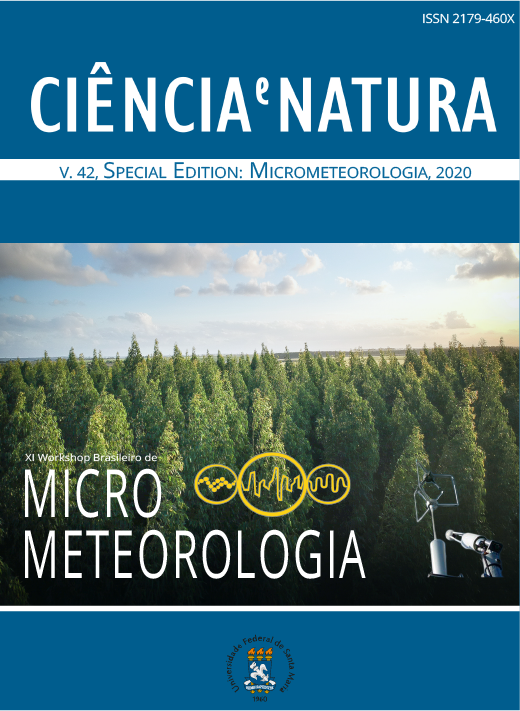Thermodynamic indexes during the GOAmazon2014/5 campaign and comparison with ERA-Interim reanalysis data
DOI:
https://doi.org/10.5902/2179460X46842Keywords:
Amazon, GoAmazon2014/5, Convection, Thermodynamic indexes, Seasonality, ERA-Interim ReanalysisAbstract
The thermodynamic indexes LCL, LFC, CINE and CAPE characterize atmospheric instability, and allow the study of cloud formation and convection, important phenomena for the hydrologic cycle and the radiative balance. For this reason, this work makes a seasonal analysis of these thermodynamic indexes computed from radiosondes released during the GOAmazon2014/5 experiment. A comparison was made with ERA-Interim reanalysis for both these indexes and the temperature and relative humidity profiles. Analysis of radiosonde data shows that the median vertical profile of relative humidity in the dry season was lower in 2015 when compared to 2014, resulting in higher LCL (~50 hPa at 18 Z) and lower CAPE (~50% lower). The difference stems from a more severe dry season in 2015 when compared with 2014. The comparison with the reanalysis reveals that modeled LCL values are only compatible with observed ones at 18 Z (mean bias -10 hPa). On the other hand, CAPE values are always incompatible (mean bias -750 j/kg). Results indicate that ERA Interim poorly represents the thermodynamic conditions over the Amazon rainforest.
Downloads
References
BAO, X.; ZHANG, F. Evaluation of NCEP-CFSR, NCEP-NCAR, ERA-INTERIM, and ERA-40 reanalysis datasets against independent sounding observations over the Tibetan plateau. Journal of Climate, v. 26, p. 206–214, 01 2013.
BUENO, P. G. Investigação da camada limite planetária convectiva com modelo LES aplicado à dispersão de poluentes. 2018. 155 f. Tese (Doutorado em Meterologia) — IAG-Universidade de São Paulo, 2018., São Paulo, 2018.
COLLOW, A. B. M.; MILLER, M. A.; TRABACHINO, L. C. Cloudiness over the amazon rainforest: Meteorology and thermodynamics. Journal of Geophysical Research: Atmospheres, v. 121, p. 7990–8005, 2016.
COMET METED. Tephigram Mastery. Meted, 2019. Disponível em: https://www.meted.ucar.edu/ mesoprim/tephigram.
DEE, D. P. et al. The ERA-Interim reanalysis: configuration and performance of the data assimilation system. Quarterly Journal of the Royal Meteorological Society, v. 137, p. 553–597, abr. 2011.
Holdridge, D., et al. Balloon-Borne Sounding System (SONDE) Handbook, Tech. Rep. DOE/SC-ARM/TR-2029, Atmos. Radiat. Meas. Program, Washington, D. C., 2011. Disponível em: https://www.arm.gov/capabilities/instruments/sonde
MACHADO, L. A. T. et al. Precipitation characteristics and sensitivities to environmental conditions during goamazon2014/5 and ACRIDICONCHUVA. Atmospheric Chemistry and Physics, v. 18, p. 6461–6482, 2018.
MARTIN, S. T. et al. Introduction: Observations and modeling of the green ocean amazon (GOAMAZON2014/5). Atmospheric Chemistry and Physics, v. 16, p. 4785–4797, 2016.
University of Wyoming. Sounding. Wyoming, 2019. Disponível em: http://weather.uwyo.edu/ upperair/sounding.html.
Downloads
Published
How to Cite
Issue
Section
License
To access the DECLARATION AND TRANSFER OF COPYRIGHT AUTHOR’S DECLARATION AND COPYRIGHT LICENSE click here.
Ethical Guidelines for Journal Publication
The Ciência e Natura journal is committed to ensuring ethics in publication and quality of articles.
Conformance to standards of ethical behavior is therefore expected of all parties involved: Authors, Editors, Reviewers, and the Publisher.
In particular,
Authors: Authors should present an objective discussion of the significance of research work as well as sufficient detail and references to permit others to replicate the experiments. Fraudulent or knowingly inaccurate statements constitute unethical behavior and are unacceptable. Review Articles should also be objective, comprehensive, and accurate accounts of the state of the art. The Authors should ensure that their work is entirely original works, and if the work and/or words of others have been used, this has been appropriately acknowledged. Plagiarism in all its forms constitutes unethical publishing behavior and is unacceptable. Submitting the same manuscript to more than one journal concurrently constitutes unethical publishing behavior and is unacceptable. Authors should not submit articles describing essentially the same research to more than one journal. The corresponding Author should ensure that there is a full consensus of all Co-authors in approving the final version of the paper and its submission for publication.
Editors: Editors should evaluate manuscripts exclusively on the basis of their academic merit. An Editor must not use unpublished information in the editor's own research without the express written consent of the Author. Editors should take reasonable responsive measures when ethical complaints have been presented concerning a submitted manuscript or published paper.
Reviewers: Any manuscripts received for review must be treated as confidential documents. Privileged information or ideas obtained through peer review must be kept confidential and not used for personal advantage. Reviewers should be conducted objectively, and observations should be formulated clearly with supporting arguments, so that Authors can use them for improving the paper. Any selected Reviewer who feels unqualified to review the research reported in a manuscript or knows that its prompt review will be impossible should notify the Editor and excuse himself from the review process. Reviewers should not consider manuscripts in which they have conflicts of interest resulting from competitive, collaborative, or other relationships or connections with any of the authors, companies, or institutions connected to the papers.






